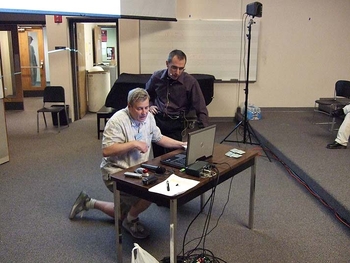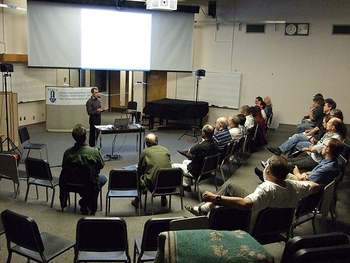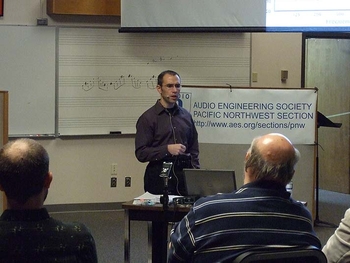
Meeting held Tuesday, June 23, 2009 At Shoreline Community College

Committee member Bob Smith attends to some playback details before the meeting. |

The audience is listening. |

John Young, Puget Sound Hearing and Balance |
| Photos by Gary Louie | ||
The PNW Section held its June general and business/elections meeting at Shoreline Community College in Shoreline, WA, north of Seattle. The featured speaker was John Young of Puget Sound Hearing and Balance, discussing hearing, hearing conservation, and hearing assistance devices featuring a local case study, retired CBS Records engineer Frank Laico. Many attendees were from Shoreline's audio technology program. 16 AES members and 9 non attended (25 total)
PNW Chair Steve Turnidge opened the meeting, and all attendees did self introductions.
John started by distinguishing between research audiologists and clinical audiologists such as himself. He works with a medical doctor. Then he showed how hearing is measured with the audiogram, the chart showing the person's hearing response deviation from normal. Such a chart may seem obvious to an audio person, but many ordinary patients never have this explained to them, or told what it means for their treatment. Any loss is described variously as "mild, moderate, severe, profound" The typical testing stops at 8k-12kHz.
John continued with how we hear, describing the parts of the ear (the outer, middle and inner ear) and how they function. The outer ear (pinna/canal) - amplifies and reflects desired frequencies. It's a resonant chamber. The middle ear is an impedence matcher, as the eardrum couples the air movement to mechanical movement with the three small bones and then to the fluid of the inner ear.
He described the stapedial or acoustic reflex, which is a human built-in protection from loud sounds. Sadly it only works for about 15 seconds, even though it gives a nice 30dB attenuation. It diminishes with hearing loss. The inner ear performs a frequency analysis and creates the electric impulses of sound for the brain. Pictures and diagrams of the cochlea, basal membrane, window and hair cells were shown. There is still some question about how everything exactly works.
There was a simplified discussion of speech processing in the brain - highs for consonants and clarity; lows for vowels and loudness. Thus a hearing aid needs to be tailored for a person. Just because the sound is loud doesn't mean the person will understand it.
Next was a discussion of noise and noise exposure. Noise here has no standard definition, so we can play with definitions. John suggested aperiodic acoustic signals which can negatively affect the physiological or psychological well-being of an individual.
Measurement of sound and noise began with the Fletcher Munson equal loudness curve of human hearing, then the A, B, C, and D sound weighting curves - "A" wtd. is widely used, though not so scientifically useful because of its bass roll-off.
Regarding noise exposure and the law, the American NIOSH standard is 85dBA for 8 hours. OSHA is 90dBA/8 hours. These are probably not adequate. NIOSH also says for an increase of 3dB, halve the exposure time. Over 115dBA, don't be in it unprotected. OSHA & NIOSH standards were compared, and a chart of dBSPL of various common sounds was shown.
Noise causes loss by acoustic trauma (damage) from the percussive loud sounds. This physically damages the hearing bones and hair cells. The consequences of loss include tinnitis (ringing in the ear, and as the loss gets worse, the ringing get louder), sleep disturbance, poor concentration, mood swings, stress, decreased sound tolerance, and depression/isolation.
Dollar loss from hearing loss can average $250k over a lifetime, more for younger people. Children can have language/learning delays, hearing aids can be $3k-6k, plus other fees and the cost of batteries. There's a stigma, inconvenience and often a cognitive decline.
John played an audio example that simulated before and after various hearing losses. Problems from hearing loss were discussed such as loudness recruitment (abnormal sensation of dynamics), pitch distortion, problems localizing, vestibular (balance) problems and temporary threshold shifts. Even some student tests have been shown to be lower from masking noise.
Personal music player loss was mentioned, as people listen longer and louder. Surprisingly to some, it seems 30% of rock & 58% of classical musicians have hearing loss. Also cited were hearing losses by music teachers, bar and club wait staff, sound engineers, and DJs.
A break was held for the Section elections. The nominations for the open positions were Steve Turnidge-chair, Rick Chinn-vice chair, Gary Louie-secretary, Dave Franzwa-treasurer, with Bob Smith, Dan Mortensen, Aurika Hays, Greg Mauser and Dr. Mike Matesky for the committee. With no write-in nominations, a voice vote was held for the slate as presented with all ayes/no nays and accepted.
Door prize winners:
CDs from Opus 4 Studios won by: James Johnston, Greg Mauser
Earplugs won by: Rob Baum, Gary Louie, Doug Hayman
Continuing after the break, John discussed conserving our hearing by:
Hearing protection devices were discussed next. They all have a Noise Reduction Rating (NRR) in dBA, but the reality is that they will not be as effective as rated. John described options such as earmuffs, foam plugs, premolded plugs (3 flange style is best), custom molded, electronic, hunters plugs (valved), and others. He noted that earplugs plus muffs don't sum the NRR, and when in sounds over 105dBA, doubling up is recommended.
For musicians, plugs with Etymotic inserts were suggested, with 9, 15, or 25dBA attenuation. In ear monitor (IEM) usage was explained, and advantages/disadvantages discussed.
Finally, a local case study with retired CBS Records engineer Frank Laico was presented. He already had hearing aids, but was dissatisfied, and came to John's clinic. He had hearing loss, tinnitis, imbalance, and a perforated right eardrum (from a botched cleaning treatment). Eardrum repair attempts (tympaniplasties) were not good, and he needed a "cholestiatoma" (growth behind the eardrum) removed. Tests showed this condition.
Frank's chart with profound loss was shown. After a careful analysis of his condition, new hearing aids were prescribed which he found to be much better. One interesting feature of the new aids was the capability to transpose frequency channels into a hearer's more sensitive channels. PNW Committee person Bob Smith created a simulation of what Frank might hear. While it may sound distorted to a person with normal hearing, the tranposition of some sounds allows a patient to finally hear important speech sounds at all, and the brain can easily adapt to the "new" sound and learn to understand it.
Reported by Gary Louie, PNW Section Secretary
Last modified 11/09/2009. 11:10:54